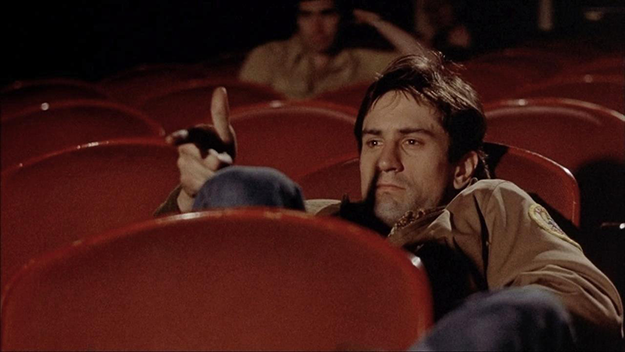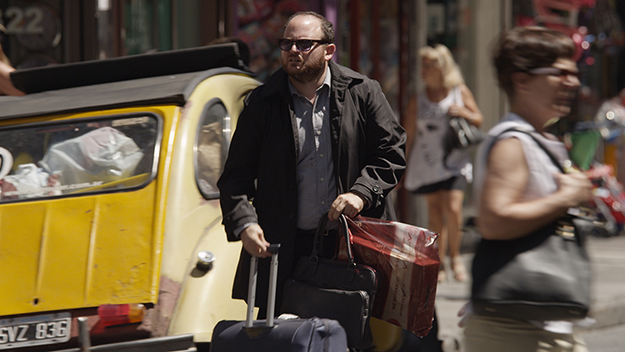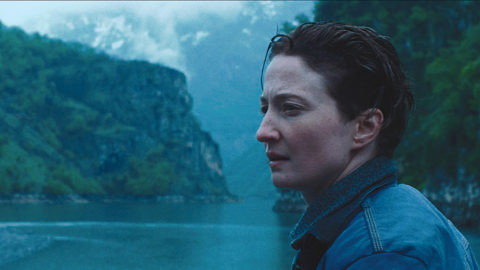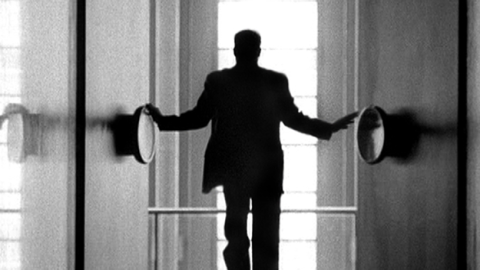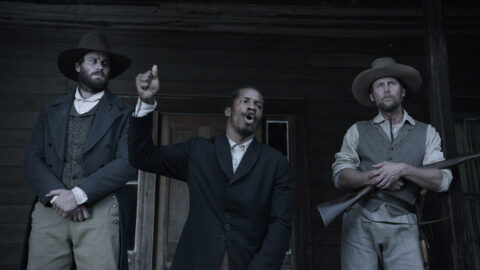Festivals: Tribeca
Taxi Driver
This year was the 15th anniversary of the Tribeca Film Festival. Yes, time flies. It has flown even faster for the talent on stage at the Beacon Theatre after one of the festival’s galas, the 40th anniversary screening of Taxi Driver, which took place just two days short of the 400th anniversary of the death of William Shakespeare. Better that no one was aware: the coincidence might have inspired a critic as keen for a fresh angle as I am right now to pose the question, “Is Travis Bickle our Hamlet?”
Moderated by New York Film Festival director Kent Jones, the post-screening panel included the three usual suspects: Tribeca Film Festival co-founder Robert De Niro, director Martin Scorsese, and writer Paul Schrader, plus actors Jodie Foster, Cybill Shepherd, Harvey Keitel, and producer Michael Phillips. There were no revelations, but the audience, fortified by free popcorn and soda, and of course the movie itself, gave them a standing ovation. Taxi Driver seems perhaps more relevant today than ever, although now that racist and misogynist rage saturates the Internet, Travis is no longer “God’s lonely man.” Digital projection, however, does not do justice to the mix of shadows, mist, and blazing primary colors that Scorsese and cinematographer Michael Chapman created on 35mm as a reflection of Travis’s twisted psyche and a New York that was down, but certainly not out
Indeed, the TFF has made the capacity of New York to rebound from crisis its origin myth. It might be time, however, for the festival to stop reminding us that it was born out of the horror of 9/11, given that Tribeca itself has become the wealthiest zip code in the city, and that the economic gap between its residents and the millions of people barely able to hang on anywhere in the five boroughs may be the one disaster that New York will not survive. To those 99 percent, Tribeca offers “Free Friday,” a chance to see most of its slate of roughly 100 feature films without paying a festival ticket price that’s higher than what you would pay to see them later at your local movie theater, if they ever play there, and many times more than you’d pay to see them on VOD, if you knew where to find them. One of the best things Tribeca has done is to build its Web presence, just as Sundance has done, using its brand to give films that would have disappeared after their festival screening a long life online. It also gives a bunch of monetary prizes to filmmakers, which is as good a benefit as festival exposure.
The Tenth Man
As a critic, I have no reason to complain about the TFF, which makes our lives easy by offering weeks of pre-festival press and industry screenings, and, once the festival starts, morning P&I screenings at the cavernous Regal Battery Park Stadium 11, where no one stops you from leaving early and coming in late, provided there’s a seat in the theater. Given that at least half the films in the festival are not compelling enough to sit through, the freedom to graze discreetly is welcome.
While documentaries are always a safer festival bet, Tribeca showed several fine fiction features. Easily the strongest and most pleasurable film I saw was Daniel Burman’s The Tenth Man, which Kino Lorber will release this summer. Set in Buenos Aires’ dilapidated but resourceful Jewish quarter El Once, it is a father-son story suffused with mysticism and humor worthy of Isaac Bashevis Singer, hybridized with Latin American magic realism. I’m not kidding, the film is that good. Ariel (Alan Sabbagh, who won best actor in the international narrative competition), a middle-aged economist living in New York, visits Buenos Aires to see his father, Usher, who runs an organization that provides for the needy using “unorthodox “ methods. (Usher is played by the actual Usher, Burman’s inspiration for the film and, in real life, a Jewish activist and mystic, just as he is in the film.) When Ariel arrives in El Once, his father is nowhere to be found, although he frequently telephones his bewildered son to make requests that gradually draw Ariel back into the observant Jewish community where he was born. Burman uses the teeming street life and the actual residents of El Once to great advantage: during a soup-kitchen-style Purim celebration, the image of an elderly woman with a walker slowly crossing the room combines with impromptu musical entertainment to create a moment of utter transcendence.
Closer to home, but just as ethnographically acute, Ingrid Jungermann’s Women Who Kill is a love-bite satire of Park Slope’s lesbian community. Jungermann stars as a repressed 38-year-old who does a popular podcast with her ex-girlfriend about female serial killers. Surrounded by a contingent of excellent comic actors (in a tiny role, Grace Rex is memorable), Jungermann, a triple-threat director/writer/actor, balances paranoia with reasonable fear of the dangers of intimacy. Less successful, but not without interest, Sophia Takal’s Always Shine, concerns competition between two women that may have taken a murderous turn, or are we merely seeing an actor’s fantasy about a horror film within an avant-garde film—clichés about women split and mirrored to infinity. Nicely acted but conceptually tired, Always Shine doesn’t manage to one-up Mulholland Drive; rather, it makes one crave the original.
Command and Control
Exceptional documentary storytelling, Robert Kenner’s Command and Control, focuses on a deadly explosion and near-nuclear disaster that occurred in 1980 on a missile base in Arkansas. Using incredible military footage and eyewitness testimony, Kenner traces how a tiny dropped bolt during a routine inspection, combined with unforeseen complications and inexperienced and poorly informed military personal all the way up the chain of command almost resulted in an event more deadly than Hiroshima. Kenner keeps us on the edge of our seats, using this particularly terrifying incident to open out into an investigation of the dangers of nuclear power that did not end with the cold war. (Produced by PBS’s American Experience, Command and Control will have a brief theatrical run at Film Forum in September.) Among a half-dozen other compelling documentaries were Richard Dewey and Timothy Marrinan’s Burden, an intelligent, well-researched portrait of the artist Chris Burden and the moving turn he took in his work toward the end of his life; and Cecilia Aldarondo’s Memories of a Penitent Heart and José Villalobos’s The Charro of Toluquilla, both uniquely dealing with the intractable differences between men with HIV and the Catholic families and communities where unconditional love is impossible.
Tribeca is putting energy and resources into new media with several floors of the Tribeca “Hub” devoted to Virtual Reality installations and interactive storytelling. As I wrote of the similar initiative at Sundance, the technology hasn’t caught up with the expectations and the hyperbole, but had I seen Arnaud Colinart, Amaury La Burthe, Peter Middleton, and James Spinney’s Notes on Blindness: Into Darkness at Sundance where it had its American premiere, I might have been more positive about VR in Park City. Combining the precisely observed, affecting audio-diary of John Hull, who went blind in adulthood, with delicate 3-D digital animation and an interactive component sensitive to the participant’s own movements, the makers have created a world that does not necessarily evoke Hull’s own, but is nevertheless a place that one wants to inhabit, despite the tiresome head gear, pressing on one’s brain.
Amy Taubin is a contributing editor to FILM COMMENT and Artforum.



